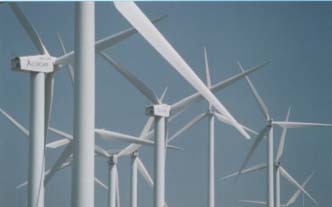| Bats and windfarms - another ecological disaster |
(1140) |
| IT´S NOT ONLY THE BIRDS: BATS GET KILLED TOO |
| As for the birds, evidence has started to come in about bats being slaughtered by windfarms. |

From Navarre, Spain, we have evidence that bats are being killed in large numbers by the blades of wind turbines (Dr. Lekuona* estimated that 368 turbines killed 650 bats in just one year). This shows that eyes plus radar-like perception plus extreme manoeuvrability are unable to save flying creatures from wind turbines.
*see: The negative effects of windfarms: links to papers published by Mark Duchamp
In the US: the blades of the 44 wind turbines atop Backbone Mountain in Tucker County, West Virginia, killed more than 2,000 bats and nearly 200 birds in 2003, researchers estimate. Merlin Tuttle, director of Bat Conservation International in Austin, Texas, thinks that real mortality at the windfarm is closer to 4,000 bats: “I believe that to be the consensus of other experts. One of the things experts have said: This sampling* wouldn’t pass scientific peer review."
*Sampling: the number of carcasses actually found, which often tends to minimize actual mortality.
Germany: we received the following comments from Professor Hans Erkert, University of Tuebingen, Institute for Zoology, Tübingen:
"In Germany up to now only a few studies on the effect of wind turbines on the bat fauna have been carried out. However, these few studies already show that wind turbines indeed may have fatal consequences for migrating bats and/or local bat populations. So, below wind turbines a considerable number of dead bats have been found.
In Sweden and Germany the collected victimes of windplants belonged to 10 bat species. Since many of the victims found in late summer and autumn belonged to migrating species bat specialists assume that they are mainly killed while migrating to their winter quarters. And during migration these bats probably do not use their ultrasound sonar system intensely for orientation but may rely more on vision or on any other yet unknown sense of orientation (e.g. the use of the magnetic field of earth like some birds). However, besides such migrating species also a considerable number of non-migrating bats have been found among the victims collected below wind turbines.
Starting from this observation specialists have asked the question whether wind turbines may attract hunting bats – probably because the waste heat of the hub or the navigation lights may attract insects of prey which then accumulate in the danger zone of the rotor. A hypothesis proposed by some bat specialists who tried to explain why bats are killed by windplants despite their usually very effective echolocation system is that, due to the special shape of the rotor blades, the bats’ ultrasound pulses may be not reflected towards the ears of the animals but deflected into other directions so that the animals are “acoustically blind” in this specific orienting situation.
As already mentioned by our Spanish colleague, the extremely high rotation speed of tips of rotor blades is another very critical safety hazard for hunting bats. Not (completely) understood is furthermore the observation that many bats found dead below large wind turbines did not show any signs of injuries pointing to a hit produced by the rotor. Because of some other observations made in such bats several scientists now assume that the rotating windmill sails produce a subpressure which causes the bats’ death when they are passing this decompression zone (principle: decompression sickness in divers coming up too fast).
In summary: We now know that many of our strongly protected bats are killed by wind turbines, however, we do not yet know the true reasons of this disaster. Nevertheless, the bat specialists among our animal conservationists therefore claim that, in case of planning large windplants also their possible effect on migrating bats and the local bat fauna should no longer be ignored because, at least in Europe, bats belong to the most endangered mammals."
Source: Brinkman, R. and Schauer-Weisshahn, H. (2002): Welche Auswirkungen haben Windenergieanlagen auf Fledermäuse? In: "Der Flattermann", Mitteilungen der Arbeitsgemeinschaft Fledermausschutz Baden-Württemberg e.V.,
Vol. 14, pp 21-22. Robert.Brinkmann@t-online.de and Horst
Schauer-Weisshahn (weisshahn@arcor.de).
For information on bird mortality, and other little-known aspects of windfarming, see here:
The negative effects of windfarms: links to papers published by Mark Duchamp
Mark Duchamp
markduchamp@hotmail.com
| Insertado
por: Mark Duchamp (07/11/2003) |
| Fuente/Autor:
Mark Duchamp Wildlife advocate |
Valoración
Comentarios
|
